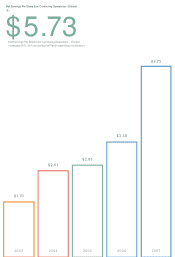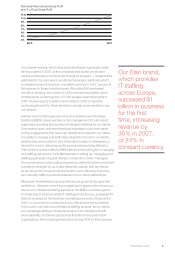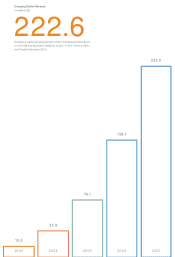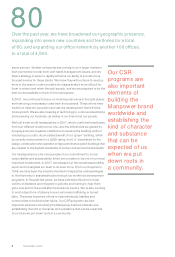ManpowerGroup 2007 Annual Report Download - page 17
Download and view the complete annual report
Please find page 17 of the 2007 ManpowerGroup annual report below. You can navigate through the pages in the report by either clicking on the pages listed below, or by using the keyword search tool below to find specific information within the annual report.Management’s Discussion & Analysis14 Manpower 2007 Annual Report
Management’s Discussion & Analysis
of financial condition and results of operations
We manage these trends by leveraging established strengths, including one of the employment services industry’s best-
recognized brands; geographic diversifi cation; size and service scope; an innovative product mix; and a strong client base.
While staffi ng is an important aspect of our business, our strategy is focused on providing both the skilled employees our clients
need and high-value workforce management, outsourcing and consulting solutions.
Client demand for employment services is dependent on the overall strength of the labor market and secular trends toward
greater workforce fl exibility within each of the countries in which we operate. Improving economic growth typically results in
increasing demand for labor, resulting in greater demand for our staffi ng services. Correspondingly, during periods of weak
economic growth or economic contraction, the demand for our staffi ng services typically declines, while demand for our
outplacement services typically accelerates.
During the last several years, secular trends toward greater workforce fl exibility have had a favorable impact on demand for our
staffing services in several markets. As companies attempt to increase the variability of their cost base, contemporary
work solutions help them to effectively address the fl uctuating demand for their products or services. Due to our industry’s
dependence on economic factors, the inherent diffi culty in forecasting the direction and strength of the economy and the
short-term nature of staffi ng assignments, it is diffi cult to forecast future demand for our services with any certainty. As a result,
we monitor a number of economic indicators, as well as recent business trends, to predict future revenue growth trends. Based
upon these anticipated trends, we determine whether additional personnel and offi ce investments are necessary to take full
advantage of growth opportunities.
Our staffi ng business is organized and managed primarily on a geographic basis, and Jefferson Wells and Right Management
are operated as separate global business units. Each country and business unit generally has its own distinct operations, and is
managed locally by its own management team. Each operation reports directly or indirectly through a regional manager, to a
member of executive management. Given this reporting structure, all of our operations have been segregated into the following
reporting segments: United States; France; Other EMEA (Europe, Middle East and Africa, excluding France and Italy); Italy;
Jefferson Wells; Right Management; and Other Operations.
The United States, France, Other EMEA, Italy and Other Operations segments derive a signifi cant majority of their revenues
from the placement of contingent workers. The remaining revenues within these segments are derived from other human
resource services, including permanent employee recruitment, temporary and permanent employee testing, selection, and
training and development. Jefferson Wells’ revenues are derived from services related to internal controls, tax, technology risk
management, and fi nance and accounting. Right Management’s revenues are derived from outplacement and consulting
services. Segment revenues represent sales to external clients. Due to the nature of our business, we generally do not have
export or intersegment sales. We provide services to a wide variety of clients, none of which individually comprises a signifi cant
portion of revenue for us as a whole or for any segment.
FINANCIAL MEASURES – CONSTANT CURRENCY
Changes in our revenues and operating profi ts include the impact of changes in foreign currency exchange rates and acquisitions
and dispositions. We provide “constant currency” and “organic constant currency” calculations in this annual report to remove
the impact of these items. We express year-over-year variances that are calculated in constant currency and organic constant
currency as a percentage.
When we use the term “constant currency,” it means that we have translated fi nancial data for a period into U.S. Dollars using
the same foreign currency exchange rates that we used to translate fi nancial data for the prior year period. We believe that this
calculation is a useful measure, indicating the actual growth of our operations. We use constant currency results in our analysis
of subsidiary or segment performance. We also use constant currency when analyzing our performance against that of our
competitors. Substantially all of our subsidiaries derive revenues and incur expenses within a single country and, consequently,
do not generally incur currency risks in connection with the conduct of their normal business operations. Changes in foreign
currency exchange rates primarily impact only reported earnings and not our actual cash fl ow or economic condition.
When we use the term “organic constant currency,” it means that we have further removed the impact of acquisitions in the
current period and dispositions from the prior period from our constant currency calculation. We believe that this calculation is
useful because it allows us to show the actual growth of our pre-existing business.
Constant currency and organic constant currency percent variances, along with a reconciliation of these amounts to certain of
our reported results, are included on page 21.
























